 My daughter used to yell at, throw things at, and chase our cats. Although she never hit them, the behavior she exhibited scared our cats to the point in which they became wary of her. Our Siamese, Scott, would hiss at her when she’d pass by and our Scottish Fold, Opie, avoided her as much as possible.
My daughter used to yell at, throw things at, and chase our cats. Although she never hit them, the behavior she exhibited scared our cats to the point in which they became wary of her. Our Siamese, Scott, would hiss at her when she’d pass by and our Scottish Fold, Opie, avoided her as much as possible.
After deciding that enough was enough, we began working on some strategies to help our daughter treat our pets more kindly. With much hard work, I’m happy to report a tremendous improvement in how my toddler treats our pets. I’ve also noticed that our cats have gotten used to her and Opie even tolerates my daughter’s playful petting and antics.
As amazing as it is to see our three-year-old be kinder and more gentle to our pets, getting to this point was not a walk in the park. These lessons took countless hours, weeks, and months of warnings and reminders. It was frustrating at times, but also a valuable lesson for me as a parent on how to encourage my toddler to listen to me without yelling.
While it wasn’t easy teaching our daughter how to be kind to our cats, it was a necessary lesson as our pets were around long before she was! In addition to the necessity, learning empathy and kindness towards animals opened the door for continuing to own pets and added some amazing benefits and positive side effects.
As my fellow pet-owning parents likely know, having both pets and children is not an easy feat. For families in which pets were around before children, we know it’s no guarantee that our children will grow up knowing how to properly treat the animals that existed in their home long before they did. For families who have children and are contemplating getting a pet, it is not an easy decision to make.
If you are in the process of weighing the benefits and risks of pet ownership with children or if you are already locked in and trying to change your child’s behavior towards a pet, look no further!
Welcome to the complete guide of all things kids and pets.
Why Pets Are Good for Kids
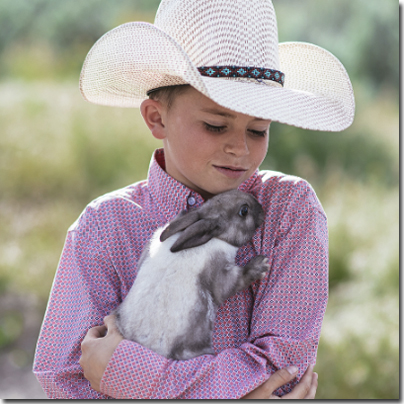 The benefits of pet ownership in families with children begin even as children are infants. Research shows that exposure to dogs and cats can make babies healthier, boost their immunity, and make them less likely to get sick in comparison to their pet-free counterparts.
The benefits of pet ownership in families with children begin even as children are infants. Research shows that exposure to dogs and cats can make babies healthier, boost their immunity, and make them less likely to get sick in comparison to their pet-free counterparts.
Other studies have shown that having pets can help a child’s development by improving their social skills, developing empathy, and increasing self-esteem. Having a pet also teaches kids how to be responsible by helping take care of the pet – feeding them, playing with them, and cleaning up after them.
For families who are not yet pet owners but have recognized the benefits and are considering the options available, there are many things to consider as you choose the pet best for you.
Does Getting a Pet Make Sense for My Family?
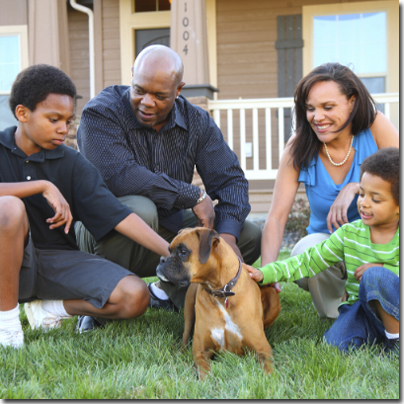 Have you ever looked at your house and realized there are a million toys laying around that your kids no longer play with? It’s a pretty simple fix: time for a giant toy purge!
Have you ever looked at your house and realized there are a million toys laying around that your kids no longer play with? It’s a pretty simple fix: time for a giant toy purge!
Unlike a castaway toy that is easy to donate, choosing to get a pet is a lifelong commitment.
Considering that pet ownership is a promise to take care of them for the rest of their life, it’s important to choose what type of pet will be suitable for your family with caution and care.
Think of the following when deciding if a having a pet is the right choice for your family’s lifestyle:
- Do your local laws or housing arrangements allow pets? Ask your landlord and building associations for pet restrictions. Consider the amount of exercise that your pet might need and the nearby places you can go to to provide that to them, especially if you’re thinking of getting a dog.
- Can you afford to take care of your pet? Consider the costs for food, litter, vet care, grooming, toys and even pet insurance. Can you allot a monthly allowance for their basic necessities?
- What is your typical working day like? Most work-from-home situations have likely made “clingy” pets so much happier as they spend more time with their owners. Is this your work situation and will it be forever? Will you travel often or be away from home for extensive periods of time? Some pets need more attention, feeding, and exercise than others.
- Who else can take care of your pet? If you’re not available, is there someone who can feed your pet, clean their litter and play with them? Think of pet sitting arrangements when you need to be away for long periods of time.
If you made it through these questions with answers that work for you and your family, then congrats! Pet ownership could be a positive addition to your family. Of course, the decision to proceed with owning a pet only narrows it down to hundreds of animal species and breeds.
What Type of Pet Makes Sense for My Family?
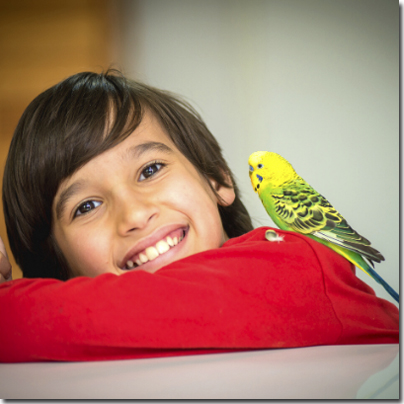
Researching the options for pets is important for an understanding of the unique traits, needs, and personalities of different animals and how they could mesh with your family. To get a better understanding of where to start, ask yourself these questions:
- Do you want a low maintenance animal, a pet that you can exercise with, or just an easy-going lap warmer?
- Are you okay with a clingy pet or do you prefer a pet that’s more independent?
- Can you consider a pet that has a long life expectancy of 30+ years (eg. birds) or more (eg. turtles)?
Taking the time to research different types of suitable, family-friendly pets, such as dogs, cats, rabbits and more unusual pets, will help you learn what to expect from them, how to care for them, and the type of commitment and lifestyle adjustments that you might have to make to keep them.
How Can My Child(ren) Be Involved?
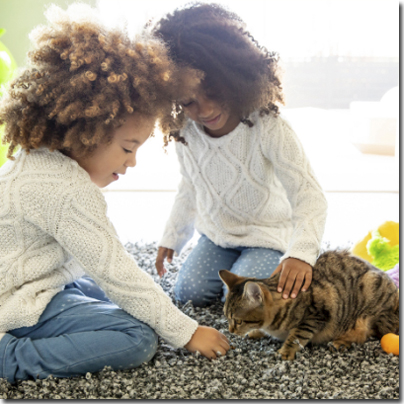 To tap into the best possible benefits of pet ownership, the age and personality of your children are important to consider when deciding what type of pet will work best for the family.
To tap into the best possible benefits of pet ownership, the age and personality of your children are important to consider when deciding what type of pet will work best for the family.
Some questions that parents may want to consider:
- Are your kids old enough to understand and follow instructions when it concerns a pet, eg. don’t pull a cat’s tail, don’t hit the dog, etc.?
- Do you have an available space for your pet if they need to have room away from curious little kids?
- Would you be able to tolerate a pet that’s noisy and active at night?
- What kind of interaction does your child want with your pet– will they want to play with it or do they prefer a low maintenance pet to occasionally hang out with?
- How much are your children motivated to be involved in the pet’s daily care?
- Are your children allergic to pet fur, have asthma or other conditions that might get worse with having a pet at home?
After assessing your family’s needs and narrowing down the choices that make the most sense for the family, it’s time to include your children in the final decision of picking a suitable pet for the family! Doing so will make your children feel more involved and will give them a sense of responsibility to take care of the pet.
For Parents with Older Children
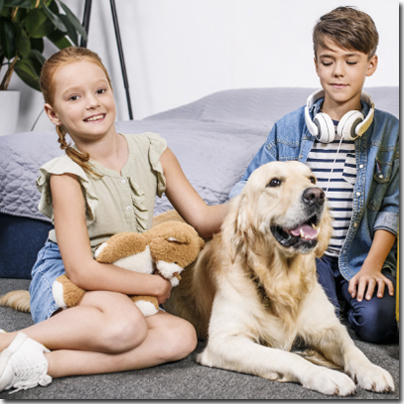 Most children of middle elementary school age and older can be fully included in the process of choosing and getting a pet by doing the following:
Most children of middle elementary school age and older can be fully included in the process of choosing and getting a pet by doing the following:
- Ask your child to consider what type of pet they would prefer, what to name it, what toys to get it, where it should sleep. Giving your children the power of choice has a lot of benefits, including feelings of empowerment, responsibility, problem-solving skills, and real-life experiences of cause and effect.
- Research together! Borrow library books about the type of pet they are interested in or watch videos and documentaries together about the animal. Learning together not only strengthens your bond with your child, it also makes it fun to learn about the pet that you want to adopt.
- Ask relatives, friends or neighbors who might own a similar pet. Visit them (if it’s possible) and ask them questions about how to take care of the pet, its nuances and quirks. If someone you know has that particular animal as a pet and is willing to allow you to spend some time with it, go for it!
- Talk to a vet. They are the best people to ask when it comes to a pet’s personality traits and may be able to suggest several pet options suitable for you and your children.
- Go with the whole family to visit a pet shelter. Observe potential pets with your kids, hear out your kids’ opinion and have a family discussion.
- Have conversation about your pet’s general traits, temperament, behavior, and in some cases, their lifespan.
- Discuss the list of possible pet care tasks your children will have to do. Tell them what kind of help you’ll expect from them. It’s better to discuss these responsibilities in advance so that there are no surprises when pet care shows up on their chore list!
For Parents with Younger Children

If your kids are early elementary school or younger, you can still include them in the decision making process. For younger children, parents should narrow down pet choices significantly while still allowing them a choice in the decision. Parents of younger children may want to focus only on pets that are more suited for families with younger children.
While younger children can certainly help with pet care and pet-related chores, the responsibilities tasked to young children should be those that don’t involve direct pet handling, or parents should expect to monitor children closely if they are directly handling the pet. Young children may not be mature enough to understand the intricacies of animal care and might, at times, still treat pets as stuffed toys.
You can still involve younger children in choosing a pet for the family by doing the following:
- Choose age-appropriate books to prepare your children for a new pet and watch videos to teach them how special pets can be and how to take care of them.
- Spend time talking with your child about the pet’s traits and general behavior. This may be more engaging and fun by incorporating some listening activities, such as incorporating doll or stuffed animals into a lesson about the animal.
- Organize pet visits with your little one before taking the pet home. This allows for time to observe how the pet reacts to your child and to take note of the temperament of the pet. Frequent visits will also help young children become more familiar with the pet and will give you more time to explain and teach them about a pet’s needs.
For Parents with Babies
 Your baby may not have much of a say when it comes to choosing a pet for your family, but you can still involve them in the process by doing the following:
Your baby may not have much of a say when it comes to choosing a pet for your family, but you can still involve them in the process by doing the following:
- Once it’s safe for your baby to go out of the house, visit the pet shelter often and expose them to the potential pet as much as possible. This is a great way to get to know if your baby is allergic to a certain pet or how the pet will react to your little one.
- Allow your chosen pet to get used to your baby’s smell. Consider giving your chosen pet an unwashed piece of your baby’s clothing before bringing them home. Sound familiar? This is also encouraged when bringing a newborn home from the hospital to an already established pet.
- If it’s possible, give your chosen pet their favorite treats during and after an interaction with your baby. If it’s safe for your baby to touch the pet, give the pet a treat afterwards as positive reinforcement. This will encourage a positive association with your baby and the reward.
- Get your baby used to the noises a pet might possibly make by playing audio feedback of your pet’s noises on your TV or your phone every day; this will help condition your little one to those noises!
If your family has brought home a new furry friend, it’s now time to show and teach your children how to treat pets with love, care and respect.
How Can I Encourage My Child To Treat Their Pet Kindly?
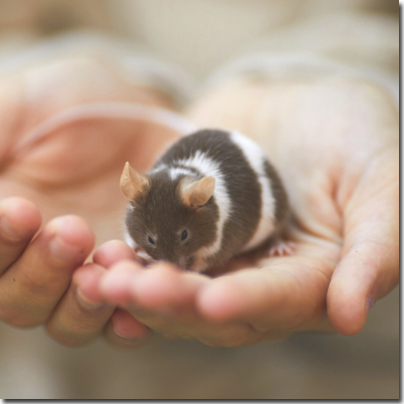 Whether you’re a new pet owner or had pets before your children were born, teaching your children how to treat animals is an absolute must. Children who have opportunities to learn these skills are more likely to generalize them to treatment of all animals, not just their own pets!
Whether you’re a new pet owner or had pets before your children were born, teaching your children how to treat animals is an absolute must. Children who have opportunities to learn these skills are more likely to generalize them to treatment of all animals, not just their own pets!
Not only does this teach your children essential life skills such as self-esteem, patience, compassion, and respect, but it also gives you peace of mind that both parties will be able to safely interact.
Here are a few effective and tested strategies for teaching your children (of ALL ages) how to be kind to your pets:
#1: Set a Good Example
 Just like all humans, children learn best by watching others model behaviors. This can be for the good or the bad; as I found out with my daughter when she almost learned a curse word! That experience made me very cautious in the way I speak and act in front of my kid.
Just like all humans, children learn best by watching others model behaviors. This can be for the good or the bad; as I found out with my daughter when she almost learned a curse word! That experience made me very cautious in the way I speak and act in front of my kid.
I love my pets dearly and I treat them as human beings–so it’s easy for me to give a good example of how my daughter should treat our cats.
Show your kids how to treat animals properly by doing the following:
- Volunteer at pet shelters. There are plenty of organizations that need extra hands in taking care of pets or fostering them. Allowing your children to participate in such activities communicates that animals need love and care.
- Visit a zoo, a farm, or go on a nature walk that will expose your children to all kinds of animals. Talk to your children about the importance of boundaries and respecting animals from a distance. This is also a good time to talk about habitats and how we can play a part in protecting an animal’s habitat.
- Support pet-related causes and initiatives. Explain to your children why you’re buying from a certain company and why they need to be supported.
#2: Talk to Pets as If They Are Your Kids
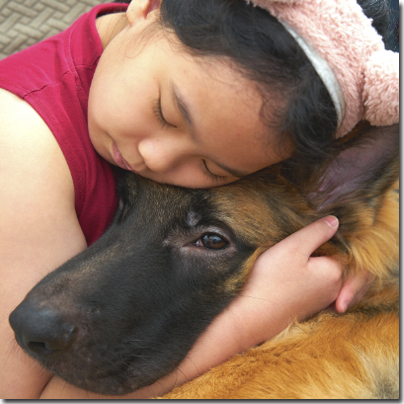 Sometimes I call our first cat by my daughter’s name and vice versa. Aside from this being the result of my own absent-mindedness, it’s also because I see my pets as my children.
Sometimes I call our first cat by my daughter’s name and vice versa. Aside from this being the result of my own absent-mindedness, it’s also because I see my pets as my children.
When my cats don’t want to eat their wet food and instead want more dry food, I talk to them how I would my daughter if she asked for snacks for breakfast. I gently turn down their request and explain to them why I’m not giving them what they want. They may be cats, but the mannerism in which we present to them does not go unnoticed by my cats or my daughter.
As modeling is the best form or teaching, I have often witnessed my daughter speaking in “baby talk” to our pets. Not only is it reassuring to hear our children speak to pets in a gentle and sweet way but there are some benefits to pets as well. Science supports that “baby talk” is an effective method to get cats and dogs to pay attention and effectively communicates a sense of our love and affection.
While baby-talking to pets may come naturally to some, if modeling this behavior for your children feels uncomfortable, you can focus on praising your pet when they do something good or deciding as a family on an endearing nickname for your pet. In time, your kids will notice, remember, and imitate these interactions!
#3: Tell Stories
When I told my daughter how Opie howled in pain when his tail got stuck between the table legs, she immediately went to Opie and petted him, asking him over and over again if he was okay.
I was touched by what she did… but I wasn’t surprised.
The toddler brain is constantly changing with new connections being made every day. This leads to learning at what can feel like an alarmingly fast rate. A toddler that can demonstrate empathy towards a pet is most likely modeling a behavior they observed someone else engage in. This observation leads to a new brain connection being made, allowing them to mimic the behavior.
Aside from the numerous benefits of story-telling, stories about pets can make your kids see animals as more human-like and relatable. Stories can give animals a personality that will engage your kid to treat pets humanely.
If your pet turtle or fish have not provided a particularly memorable narrative, you can also make up stories about your pets or retell age-old animal related fairy tales. Tips for animal story-telling include:
- Tell a popular fairy tale story and turn the main character into an animal
- Remember a friend’s anecdote, edit relevant parts, and share the revised version
- Recall a kid-friendly movie or TV show with an animal cartoon character and share a relevant scene of it with your children
- Share a time when you were feeling sad and how seeing a certain pet made you smile
#4: Talk About Animal Discomfort
 Young children won’t typically be able to tell if a pet is agitated by the former’s presence. Our Siamese cat tends to scratch and bite when he is petted without his permission–or even when he just feels like it. Frequent warnings to my daughter about the cat’s moody behavior have been helpful.
Young children won’t typically be able to tell if a pet is agitated by the former’s presence. Our Siamese cat tends to scratch and bite when he is petted without his permission–or even when he just feels like it. Frequent warnings to my daughter about the cat’s moody behavior have been helpful.
If a pet is agitated and continues to be interacted with, there is a good chance that both the pet and human could get hurt. As young children may not understand a pet’s cues, it may take frequent conversations until they are able to independently pick up on warning behaviors.
A calm dog usually has a loose mouth, relaxed posture, and a still tail and eyes. Cats are more unpredictable, but they might show that they like someone by following them around or blinking at you slowly. If your guinea pig comes to say hello or follows you around, those are sure signs that they like you.
It would be advisable to research, study, and observe your pet when they are agitated; especially pets that could potentially bite and harm children. While each animal is different, in general the warning signs of anxiety for common pets include:
Dogs:
- Yawning
- Licking their lips
- Turning their head away
- Rolling their eyes
- Stiff body
- Closed mouth
- Excessive licking and scratching
- Shaking
Cats:
- Shifting away
- Thumping their tail
- Ears rotating backwards
- Absence of purring
- Hissing
- Sudden jerks of their head to face you or your hand
- Batting your hand away with their paw
Knowing the possible consequences that come when agitating a pet not only teaches children how to be wary and careful of their actions, it also provides an opportunity to learn about cause and effect.
Practicing cause and effect can improve your child’s cognitive processes, including skills of observing and describing. When children test out and practice the cause and effect of a seemingly endless repetitive activity or play, it can also lead to the development of their physical and social skills. Learning about cause and effect also gives a child a sense of control, making them aware of how their behavior can affect others, including animals.
#5: Teach How to Touch

Our Scottish Fold is the sort of cat that will never bite or scratch, even if you can clearly see he’s in distress. Our Siamese, on the other hand, is very moody and will even bite in the middle of a petting session that he clearly asked for.
Talking to my daughter about the differences in our cats’ personalities is a must for her learning how to touch and pet them. These conversations are not just helpful in her interactions with animals but can also be generalized to the differences in human personalities.
Teach your kids how to touch your pets in ways that won’t scare or provoke them by explaining how they best like to be touched. This could include:
- Avoiding a dog’s head when petting them
- Petting cats on the scent glands that are located between the ears, under the chin, and on the cheeks
- Allowing a guinea pig to get used to your hand by moving it slowly towards them
- Petting a hamster’s back gently with your fingers
- Some turtles enjoy being petted but only if it is done properly
If you know that your younger children will be unruly around your pet and you’re quite aware that it might be a challenge for them to listen, baby gates are effective at separating them during times in which you cannot directly supervise.
#6: Give Opportunities for Being Responsible
My daughter is only three-years-old, so the most successful way for her to feed our cats is by letting her hold a cat treat and giving it to our pets. When she gets a bit older, we will gradually work into using a scoop to refill bowls with dry food.
In general, allowing children to take part in caring for pets teaches responsibility that will serve them in all areas of life. The key in motivating kids to be involved in pet care is to give responsibilities that are age appropriate, which increases the chance that they will be able to successfully follow through with them.
Age appropriate responsibilities for pet-care could include:
Toddlers and Preschoolers
- Handing you the dry food containers/packages of wet food cans
- Scooping food to put in bowl
- Giving pet treats
- Putting dirty pet bowls in the sink for washing
- Putting away pet toys
Remember to always assess the temperament of your little ones before giving them any of the above pet care responsibilities. Incorporating pet care into routines or falling back into the storytelling section we already covered can be helpful in motivating young children to engage in pet-care responsibilities.
Elementary Aged Children
- Feeding the pets
- Refilling water bowls
- Playing and exercising with the pet
- Putting away pet toys
- Brushing the pet
- Clearing and washing pet dishes
Take note to not overwhelm children at this age with too many tasks; it’s better to give them a few consistent daily tasks to allow them time to adapt and excel. It’s also helpful to be clear and specific about the tasks (eg., feed the dog twice a day, before you leave for school and before you sleep at night) and to always explain the consequence of neglecting to do the tasks.
Older Children
- Refilling the pet’s food and water bowls
- Cleaning pet cages or bedding
- Putting away pet toys
- Brushing and/or grooming the pet
- Scooping and throwing away litter
- Playing and exercising with pets
- Teaching tricks
- Checking if the pet is sick, has ticks, etc.
Sit down with your “tweens” or teenagers and draw a contract. It can be helpful to include detailed descriptions of what pet care responsibilities are expected and the consequences if they fail to do so.
#7: Support Lessons with Books and Movies
 My daughter and I have been reading books since she was only 3 months old. While there are obvious benefits of reading with children, this can also be a great way to support caring for a pet. I’ve noticed that my daughter seems to prefer books about animal and human interactions and behavior.
My daughter and I have been reading books since she was only 3 months old. While there are obvious benefits of reading with children, this can also be a great way to support caring for a pet. I’ve noticed that my daughter seems to prefer books about animal and human interactions and behavior.
So far, it has been easy to teach and remind her how to treat pets kindly because of the books we’ve read. Some great options for a variety of ages include:
- What Pet Should I Get by Dr. Suess
- Let’s Get a Pup! Said Kate by Bob Graham
- Sparky! by Jenny Offill
 Dog Training for Kids by Vanessa Estrada Marin
Dog Training for Kids by Vanessa Estrada Marin- I Found A Kitty! by Troy Cummings
- Who Wants a Tortoise? by Dave Keane
- Our Very Own Dog by Amanda McCardie
- Talking Tails by Ann Love and Jane Drake
For children who are more impacted by movies or TV shows, these can also be an informative and entertaining way to teach children of all ages how to be kind to animals.
Many of the classic films teach empathy and kindness towards animals by giving them human qualities. It’s important when deciding on these movies to consider a child’s age and ability to comprehend the sometimes complicated underlying message of the story. For older children, having discussions after the movie can be beneficial in processing the story line.
#8: Praise the Positive
 Praise is a common strategy amongst parents who want to reinforce positive behavior and I’m not shying away from this tactic. I use behavioral conditioning often and I’ve seen a huge improvement in my toddler’s behavior since implementing these techniques.
Praise is a common strategy amongst parents who want to reinforce positive behavior and I’m not shying away from this tactic. I use behavioral conditioning often and I’ve seen a huge improvement in my toddler’s behavior since implementing these techniques.
The key to the success of praise is to do it properly and consistently. When the focus is on pet interactions, praise should be specifically targeted to “catch” your child exhibiting positive and kind behavior towards animals.
Try praising your children by doing the following:
- Be specific about your compliment. For example, say “I love how you put food in the dog’s bowl. You knew the dog was hungry and you helped!”
- Catch your child doing something good when they don’t realize they are being watched. For example, when walking past your child who is gently stroking the cat, you can comment that the cat loves to be petted that way.
- Recognize effort instead of success. This is especially important when a child is learning a new responsibility or skill, as it is more likely that failure will be part of learning. For example, praise your child for attempting to feed the cat (even as you see the food is all over the floor!)
The key to positive kids and pets interactions is to consistently allow space for your child to learn and to manage your expectations as it pertains to this learning. Just like all learning, children make progress at different paces.
Children are used to being taken care of by the adults around them. For many children, having a pet will be the first experience they will encounter in which they must be the care provider. Being patient allows for a child’s amazing growth and for the positive benefits of pet-ownership to truly shine through.
The 2-Minute Action Plan For Fine Parents
For parents considering the addition of a pet to their family, take a few minutes to assess your family’s needs and what kind of animal may positively enhance the family by considering these questions:
- What does a typical day look like in our household and how can a pet fit into our routines?
- What types of animals do I instinctually see fitting well with the temperaments of our children?
- When I cross reference the first two questions here, what pet options remain?
For parents who are already pet owners and are working on increasing a child’s positive interactions with the family pet, consider that it only takes a few minutes to show your children how to care for your pets with kindness and respect. Take a few minutes to assess the following:
- How can I be purposeful in modeling positive behaviors towards our pet?
- What pet care responsibilities can I teach to my child?
- How can I incorporate storytelling to encourage my child to think of animals as more human-like?
The Ongoing Action Plan For Fine Parents
Including pet care responsibilities and times for purposeful bonding into your child’s routine is the best way to teach your children how to care and show kindness to your pet.
As you move through pet ownership as a family, remember to reiterate, repeat, model, and remind your children how to care for and treat animals by:
- Setting a positive model of the treatment of animals, both through direct modeling and through volunteering and animal support opportunities
- Utilizing books, movies, and storytelling to consistently reinforce the human-like qualities in animals that make them so endearing
- Being purposeful in having conversations about animal discomfort and being specific about an animals likes and dislikes
- Teaching one specific pet care responsibility that can belong only to your child
- Utilizing positive reinforcement and praise as a way to encourage and support
An incredibly comprehensive and insightful guide for parents! Your step-by-step approach to choosing the right pet and teaching kids how to care for them is both practical and heartwarming. The tips you provide not only make the process easier but also ensure that children learn valuable life lessons in responsibility, empathy, and compassion. This is an excellent resource for any family considering adding a pet to their home. Well done on creating such a thoughtful and valuable tool for parents!
we have been living with our beloved dog dylan for years now. the psychologist had recommended it to us because of my son’s malaise. In truth, my daughter also fell madly in love with him. and he looks like one of the family now.